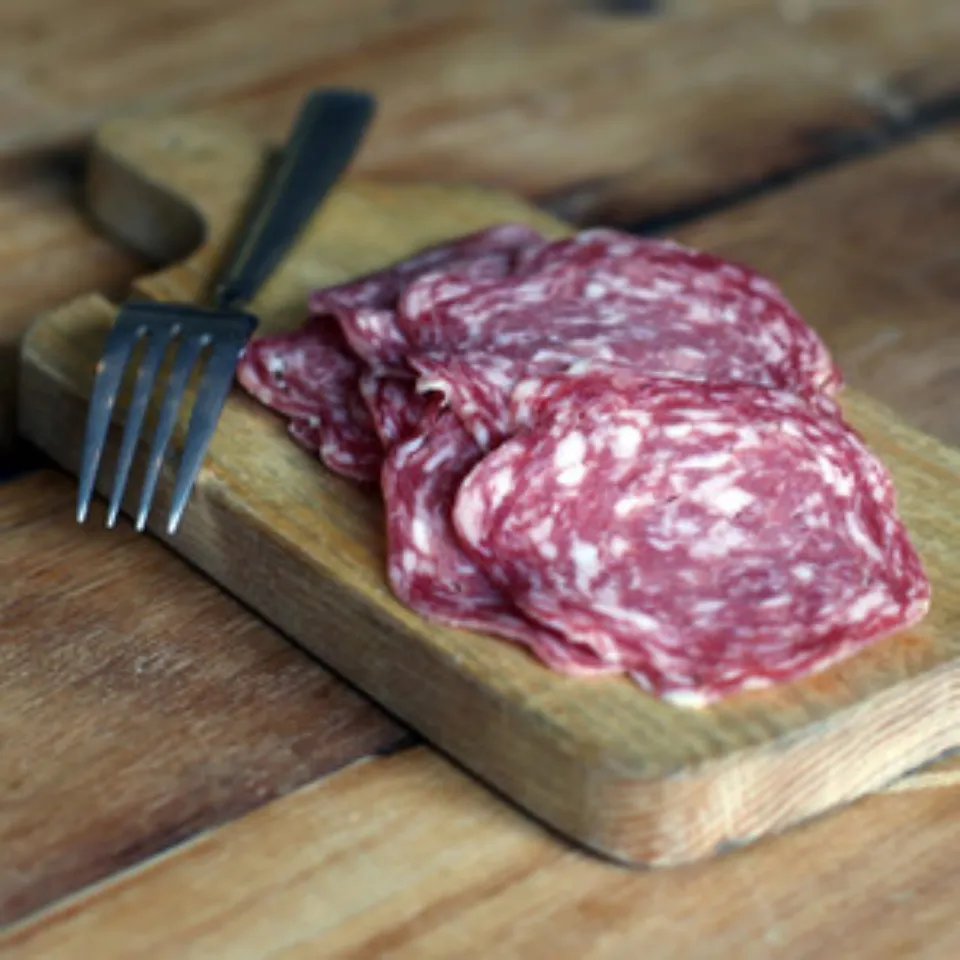
Genoa Salami vs Hard Salami: Differences & Which is Better?
A cured sausage called salami is made from ground beef and seasonings. The two most well-liked varieties are Genoa salami and hard salami. What makes a difference?
Hard salami is drier and firmer than Genoa salami because of its high protein content, reduced moisture content, and occasional fat content.
We will contrast these two varieties of salami in this article based on their ingredients, texture, manufacturing method, flavor, and more. So let’s get to it.
The History of Salami

Records of salami date back to the sixteenth century, so it has been around for hundreds of years. It is believed that salamis were first created in Europe, where people cured their meat using salt to preserve it. Food historians speculate that in order to extend the shelf life of their meats, these ancient Europeans may have first boiled them. They also claim the meat was sliced into strips and then hung it in the air, which could be why salami is often called “air-cured.”
This kind of sausage was first mentioned in print in an Antonio Latini cookbook from 1615. In this book, Latini describes it as “a type of seasoned meat that is to be eaten sliced very thin.”
Salamis rose to prominence as a breakfast food in the 1800s. Additionally, it is thought that their high availability and low cost during these times contributed to this.
There are now countless varieties of salami available in specialty shops, supermarkets, and even online, with hard salami and Genoa salami being the most well-liked varieties.
What is Hard Salami?

Hard salami, also known as cooked sausage or dry-cured salami, is distinguished by its firmer, dryer texture and slightly darker color. Although pork might be present, it is made from ground beef. Garlic, mustard seeds, and wine are all flavors that it has.
Hard salami, which has German origins, has a marbling appearance. Instead of being smoked or cooked, it usually undergoes the curing process without a casing. Hard salami can be used as a pizza topping, sandwich filling, or simply eaten on its own.
What is Genoa Salami?

Genoa, in Northern Italy, is where this type of salami was first produced. The name and the flavor are therefore both of Italian heritage. In the hilly region near Genoa, Italy, pig farming provides the majority of the country’s income and meat. Raising cattle is not an option in Genoa because there are no plains or grasslands.
The raw pork used to make traditional Genoa salami is 60% lean and 40% fat. Some variations also include equal amounts of beef meat. Due to its 2- to 3-month air-drying process at a specific temperature and humidity level, Genoa salami has a distinctive aroma. Genoa salami has a smoky aroma and a unique flavor when compared to hard salami.
Pizza and calzone fillings both use Genoa salami as a topping. Along with potatoes and goat cheese, it’s a favorite ingredient for frittatas.
Hard Salami Vs Genoa Salami: Nutritional Value
The following table shows the nutritional value found in 10 grams each of hard salami and Genoa salami:
| Nutrients | Hard Salami | Genoa Salami |
| Protein | 2.26 grams | 2.07 grams |
| Cholesterol | 8 mg | 10.2 mg |
| Fatty Acids – total saturated | 1.189 grams | 1.20 grams |
| Fatty Acids – total polyunsaturated | 0.374 grams | 0.271 grams |
| Fatty Acids – total monosaturated | 1.6 grams | 1.7 grams |
| Sodium | 226 mg | 182.6 mg |
| Iron | 0.13 mg | 0.19 mg |
| Potassium | 38 mg | 33.4 mg |
| Total Lipid | 3.37 grams | 3.33 grams |
Hard Salami Vs Genoa Salami: Comparison Chart
| Attributes | Hard Salami | Genoa Salami |
| Made Of | Hard salami is made using ground beef | Genoa salami is made using pork meat |
| Fat Content | Low fat content | High fat content |
| Color | Darker, marbled appearance | Lighter |
| Origin | Germany, Poland | Italy, Genoa |
| Flavor | Fermented | Smoked |
Hard Salami Vs Genoa Salami: Making Process

Raw material preparation, fermentation, and drying are the three main steps in the production of salami. These phases are experienced by both Genoa and hard salami. Following curing, Genoa salami goes through air drying. Hard salami also goes through a smoking process in the meantime.
During the preparation process, salami makers mix seasonings and spices with the meat. In order to help introduce good bacteria into the meat, they also add lactic acid bacteria as culture starters. A casing made of animal intestines is then placed over this mixture. Genoa salami is air dried after the curing process in a temperature- and humidity-controlled environment. In two to three months, this process typically concludes.
There is an additional step for hard salami. To speed up the fermentation process after curing, hard salami is smoked. For roughly 48 to 96 hours, the makers smoke this charcuterie. It then goes through a dehydration process to finish drying. To prevent the growth of bacteria that contaminates food, it is essential to take this step. The FSIS Identity Standards state that hard salami should have a moisture to protein ratio of 1.9 to 1, and this conforms to those standards as well.
Hard Salami Vs Genoa Salami: Flavor and Texture

Compared to the smoky flavor of hard salami, the soft and oily Genoa salami has a richer flavor and texture.
The seasonings and spices used in Genoa salami vary, and wine and vinegar are also added. These contribute to the salami’s diverse flavor profile. The combination of wine and vinegar gives it a sharp, tangy, and garlicky flavor. The peppercorns in this cured treat also give it a mild heat undertone.
Additionally, this variety typically follows the standard lean to fat ratio of 60:40 for salami. This explains why it has a moist, soft, and barely greasy texture. Despite having a similar appearance to pepperoni, they are completely different. Compared to Genoa salami, pepperoni is spicier and has more grain.
On the other hand, the smoking process gives hard salami a strong smoky flavor. It also has a dry and chewy texture due to the lower fat content. It also lives up to its reputation because it is very firm.
Ways to Eat Genoa Salami and Hard Salami

You can use either salami interchangeably because they are both versatile cured meats. They are the ideal cold meat to include on an antipasto platter as a go-to option. To highlight its complex flavors, Genoa salami is ideal with mild-flavored foods. Hard salami, on the other hand, goes well with delicate but delicious food.
Genoa salami features a sophisticated fusion of flavors. Together with some mozzarella, this makes it the ideal pizza topping. Additionally, you can use this as a meat ingredient in stromboli, calzone, and pasta dishes. Open a bottle of Chenin Blanc or a medium-bodied Pinot Noir if you’re feeling fancy. This cured treat pairs well with the sharp, tart flavor of these wines.
The smoky flavor of hard salami, meanwhile, goes well with foods with strong flavors, such as salads, subs, and cream cheese. With a glass of Chardonnay or a robust red Cabernet Sauvignon, you can also serve it with meat and various cheeses.
Genoa Salami Vs Hard Salami: Which is Better?
Depending on your preferences, there is no right or wrong answer. Grab that Genoa salami and use it in your pasta, salads, or sandwiches for that soft, tangy flavor. Hard salami, on the other hand, is always a good choice if you want something chewy, mild, and smoky in flavor. Seize the opportunity to indulge your senses. But no matter what you decide, always keep in mind that you should use it sparingly, just like everything else.
FAQs
Does Hard Salami Taste the Same as Genoa Salami?
With less fat and no wine, hard salami is made from beef. Because it is smoked, the salami becomes somewhat stiffer and ages more quickly. While Genoa salami is Italian, it is also from central Europe. While Genoa salami is quite tangy and tastes mostly of pork, hard salami has a slightly smoky and beefy flavor.
Which Salami is Best for Sandwich?
Finocchiona salami is what I usually use, but Genoa is also a common option. Any high-quality variety of salami will work, in all honesty.
How Good is Genoa Salami Good For?
If dry salami hasn’t been opened yet, it can last up to six weeks unrefrigerated, and according to the USDA, “indefinitely” in the refrigerator. Salami can only be stored for up to three weeks in the refrigerator and up to two months in the freezer because cutting it allows bacteria to enter the sausage.





Average Rating